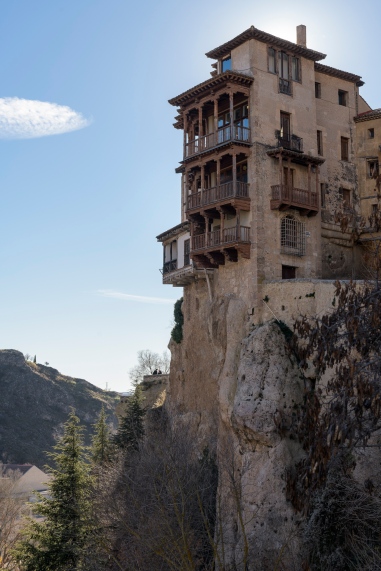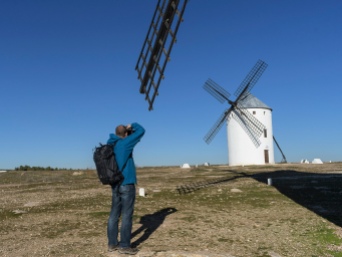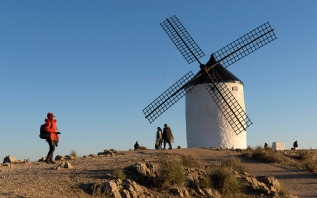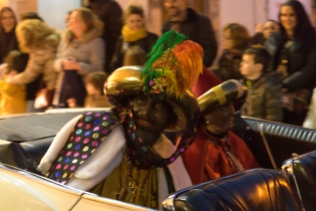We enjoy a nice Christmas break that we spend with our friends and family, celebrating the holidays, catching up and eating, eating, eating.
With our bellies full and our spirits high, it is time to continue our journey. The compass continues to point south. First it takes us to the wonderful city of Cuenca, in the Spanish region of La Mancha, which is where the Manchego cheese comes from. We get there through the almost infinite and almost lonely roads that cross the Spanish interior, through mountains and valleys covered in pine trees, holm oaks and greening cereal crops over the red earth. Probably the best of Cuenca is its spectacular setting, on top of a promontory at the meeting of two deep river gorges. The views are amazing.
It’s also quite pleasant to walk through its narrow and steep streets, flanked by old stone houses, some of them defying gravity by standing at the very edge of the cliff, proudly displaying old wooden balconies directly on top of the abyss.
We decide to sleep at the feet of the old city, at the shore of one of the rivers. The location is pleasant, but the night is so cold. We reach the -3 C, so we pump up the heating of Polaris and and add an extra blanket to our bed.
From there we want to follow the steps of Don Quixote and arrive in Campo de Criptana, where his delirium led him to think that the windmills were evil giants that he needed to fight. Truth to be told, the confusion is easy to understand, when seeing the crooked dark wings turning in the wind. We really enjoy this place, where the sky is painted in immaculate shinning blue, the time seems to have stood still and the simplicity of the windmills adds a pleasant touch of black and white sophistication to the otherwise bare landscape.
We head then to Consuegra, another town, where the windmills are displayed in an even more spectacular setting. They are lined up next to a castle on top of a hill that gives 360 views of the region. Down to the east is the little town of Consuegra and in every other direction, there’re just vast extensions of cereal crops that carpet the floor with hundreds of squarish shapes in different tones of greens and some brown earthy ways here and there. It feels that the landscape has remained unaltered for hundreds of years.
The sunset and sunrise are the most spectacular pink displays I’ve ever seen. The night in between is also extremely cold, so we pump up the heating and take the extra blanket out again.
In search of warmer climates we continue to head south and, after driving for hours through roads that cross fields of olive trees, lots of olive trees, millions and millions of olive trees, we arrive in the gorgeous Renaissance town of Úbeda. I must admit that the elegant beauty of this town in the middle of nowhere, takes us pleasantly by surprise. Strolling through the old town, which was built by the noblemen during the 16th century, one has the impression of being in some colonial town in Central America. The anatomy of the architecture in the main square and surrounding streets has a very strong resemblance to squares we have seen in towns of Guatemala, Nicaragua or Cuba. It’s not by chance that most of the crews that sailed to discovered the Americas were original from the south of Spain.
The added bonus is that we get to attend the Three Kings parade in this town. I had not seen one in the past 20 years or more and I realise that things have changed quite a bit lately, since nowadays the kings are escorted by the Star Wars troopers, the Smurfs, Sponge Bob and many others.
The temperatures have gone up a bit, but are still quite cold so we keep on heading south towards the coast of Malaga, to the town of Velez-Malaga, where we meet Susan, a Swedish ex-colleague and friend, who left her job 3 years ago, went travelling the world and then invested in an old house in this town, that she renewed. We have a nice time with her, sampling the tapas and restaurants in the town and meeting a couple of members of the Scandinavian community in town.

Dinner with Susan
We wave goodbye and head to the most southern town in Spain, Tarifa, where we want to board the ferry and cross to a new continent in this journey. Africa.































































